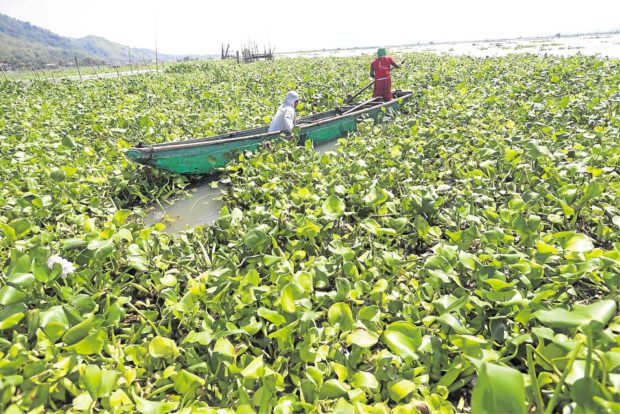Lake pollution blamed for water hyacinth nightmare

Fishermen in Binangonan town in Rizal province navigate a section of Laguna de Bay filled with water hyacinth. —REM ZAMORA
The surge of water hyacinths in Laguna de Bay only shows how “overfertilized” and polluted the water is, a problem that requires a long-term solution, according to the Laguna Lake Development Authority (LLDA).
The “infestation” being experienced by residents of Cardona town in Rizal province is a result of the water being “eutrophic” or when water is saturated with nutrients, allowing algae and phytoplankton to thrive, said Adelina Borja of the LLDA’s Resource Management and Development Office.
Perennial problem
The nutrients, she said, have come mainly from domestic and agricultural wastes that settled over time in
the 90,000-hectare Laguna de Bay, the largest inland body
of water in the country.
“[Water hyacinths] are a perennial problem, in fact not only in the (Laguna) lake but also in its tributaries,” Borja said in a telephone interview.
Article continues after this advertisementBodies of water in other countries, like Lake Victoria in Africa and Lake Chapala in Mexico, also experience the same problem, she said.
Article continues after this advertisementResidents of Cardona, about two weeks ago, woke up to swaths of water hyacinths virtually isolating their 14 villages, including those on the island of Talim.
‘Amihan’ season
The water hyacinth infestation affected more than 8,000 fishermen, who could not sail out to fish, prompting the local government to declare the town under a state of calamity.
Residents are also suffering from insect bites as mosquitoes and gnats begin to thrive in the water hyacinths.
Borja said the northeast monsoon (“amihan”) “aggravated” the situation, with the wind driving the water hyacinths to accumulate in that section of the lake.
“They (water hyacinths) also tend to grow and multiply fast,” she added.
The LLDA has started talking to officials of the Department of Public Works and Highways and the Metropolitan Manila Development Authority so the agency can use their equipment to haul tons of water hyacinths out of the lake.
The government of Cardona will also begin distributing relief packages to affected communities.
“Another thing we are currently discussing is where to dump the water hyacinths [once these are hauled]. You can’t just move them to another part of the lake,” Borja said.